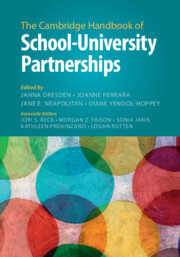Book contents
- The Cambridge Handbook of School–University Partnerships
- The Cambridge Handbook of School–University Partnerships
- Copyright page
- Contents
- Figures
- Tables
- Contributors
- Foreword
- Preface
- Acknowledgments
- Part I The History and Conceptual Foundations of School–University Partnerships
- Introduction to Part I: The History and Conceptual Foundations of School–University Partnerships
- 1 Origins
- 2 The Legacy of John I. Goodlad (1920–2014)
- 3 More Commonalities Than Differences
- 4 From Holmes to Here
- 5 Theorizing Partnership Work
- 6 The Metaphors We Partner By
- 7 Commentary: Focus versus Locus
- 8 Commentary: From Mission to Metaphors and Questions in Between
- 9 Commentary: Historical Perspectives and Conceptual Foundations of School–University Partnerships
- Part II Teachers and Learning to Teach in School–University Partnerships
- Part III Equity and Student Learning in School–University Partnerships
- Part IV Leadership in School–University Partnerships
- Part V Community Schools as School–University Partnerships
- Part VI Inquiry and Innovation in School–University Partnerships
- Part VII Funding, Policy, and the Politics of School–University Partnerships
- Part VIII Looking at School–University Partnerships across Geographic and Cultural Borders
- Index
- References
3 - More Commonalities Than Differences
Mapping the Field of Collaborative Education Research through Process
from Part I - The History and Conceptual Foundations of School–University Partnerships
Published online by Cambridge University Press: 05 November 2025
- The Cambridge Handbook of School–University Partnerships
- The Cambridge Handbook of School–University Partnerships
- Copyright page
- Contents
- Figures
- Tables
- Contributors
- Foreword
- Preface
- Acknowledgments
- Part I The History and Conceptual Foundations of School–University Partnerships
- Introduction to Part I: The History and Conceptual Foundations of School–University Partnerships
- 1 Origins
- 2 The Legacy of John I. Goodlad (1920–2014)
- 3 More Commonalities Than Differences
- 4 From Holmes to Here
- 5 Theorizing Partnership Work
- 6 The Metaphors We Partner By
- 7 Commentary: Focus versus Locus
- 8 Commentary: From Mission to Metaphors and Questions in Between
- 9 Commentary: Historical Perspectives and Conceptual Foundations of School–University Partnerships
- Part II Teachers and Learning to Teach in School–University Partnerships
- Part III Equity and Student Learning in School–University Partnerships
- Part IV Leadership in School–University Partnerships
- Part V Community Schools as School–University Partnerships
- Part VI Inquiry and Innovation in School–University Partnerships
- Part VII Funding, Policy, and the Politics of School–University Partnerships
- Part VIII Looking at School–University Partnerships across Geographic and Cultural Borders
- Index
- References
Summary
As school–university partnerships (SUPs) continue to establish themselves in the larger context of improvement efforts in the field of education, it is less clear how they relate in design, process, and outcomes to other types of collaborative education research efforts (Penuel et al., 2020). In this study, we address calls for research on school-university partnerships (Darling-Hammond, 1994; Coburn & Penuel, 2016; Farrell et al., 2022) by examining the inputs and processes of different variations of collaborative education research (Penuel et al., 2020). We hypothesize that the inputs and processes of these collaborations have more similarities than differences. To test this hypothesis, we selected purposeful cases of a professional development school and a research–practice partnership launched during the same time period – the 1990s. Findings and implications for the field of collaborative education research and school–university partnerships are discussed.
Keywords
Information
- Type
- Chapter
- Information
- The Cambridge Handbook of School–University Partnerships , pp. 42 - 64Publisher: Cambridge University PressPrint publication year: 2025
References
Accessibility standard: WCAG 2.1 AA
Why this information is here
This section outlines the accessibility features of this content - including support for screen readers, full keyboard navigation and high-contrast display options. This may not be relevant for you.Accessibility Information
Content Navigation
Allows you to navigate directly to chapters, sections, or non‐text items through a linked table of contents, reducing the need for extensive scrolling.
Provides an interactive index, letting you go straight to where a term or subject appears in the text without manual searching.
Reading Order & Textual Equivalents
You will encounter all content (including footnotes, captions, etc.) in a clear, sequential flow, making it easier to follow with assistive tools like screen readers.
Visual Accessibility
You will still understand key ideas or prompts without relying solely on colour, which is especially helpful if you have colour vision deficiencies.
Structural and Technical Features
You gain clarity from ARIA (Accessible Rich Internet Applications) roles and attributes, as they help assistive technologies interpret how each part of the content functions.
